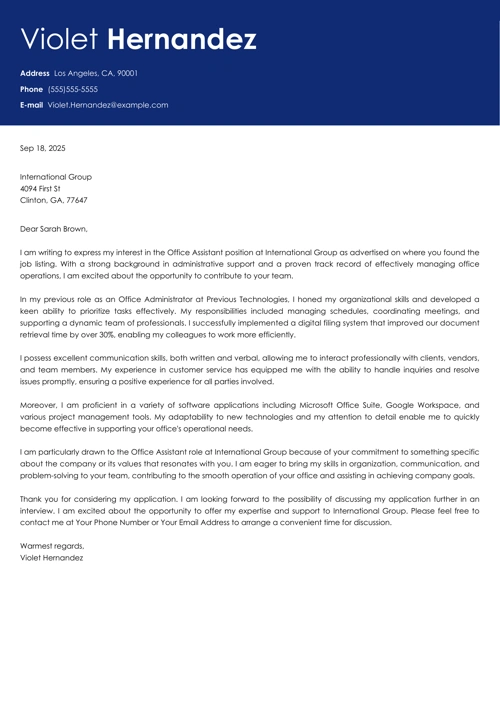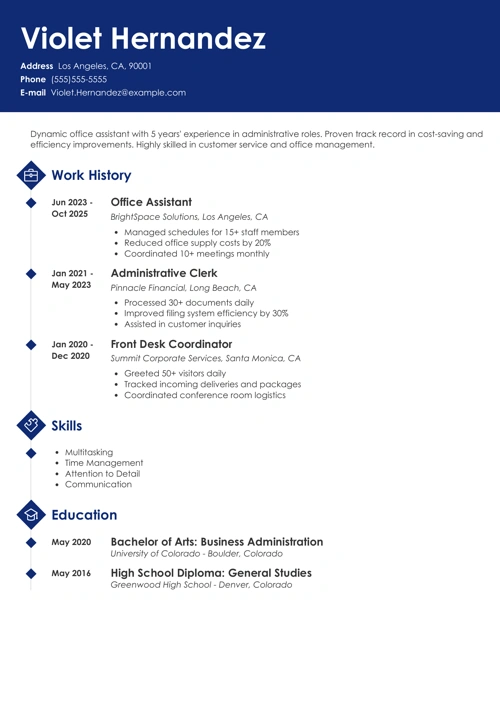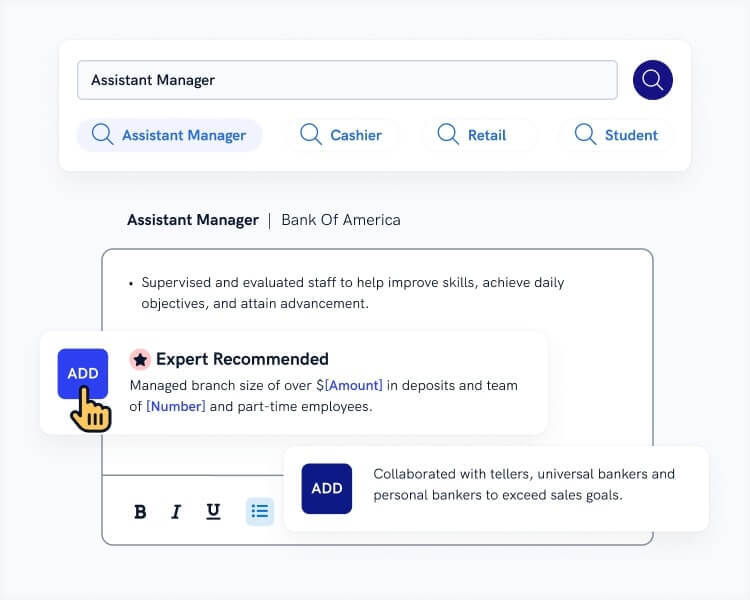A cold call cover letter (also known as an unsolicited cover letter) is a document you send with your resume for a position that isn’t officially open. Just like a cover letter for a resume, a cold cover letter highlights your skill set and job experience to convince the recruiter that you’re the person for the job.
We’ll show you exactly how an unsolicited cover letter works and how to write one that will get anyone to warm up to you in no time.
Want to write your cover letter fast? Use our cover letter builder. Choose from 20+ professional cover letter templates that match your resume. See actionable examples and get expert tips along the way.
Sample cover letter for a resume—See more cover letter examples and create your cover letter here.
Check out these other guides we have about specific types cover letters:
- What is a Cover Letter for a Resume?
- Cover Letter vs Resume: Difference
- Cover Letter vs CV: Difference
- Cover Letter for Internship
- Email Cover Letter
- How to Write a Pain Letter
- What is a Motivation Letter
- What is a Letter of Intent
- Letter of Intent vs Cover Letter: Differences
- Cover Letter Examples for Any Job
Cold Cover Letter Sample
Martha Vineyard
Office Assistant
23 Cactus Rd
Glendale, AZ 85381
608 754 4829
martha.z.vineyard@gmail.com
linkedin.com/in/marthazvineyard
Molly Butters
HR Manager
Inky Ltd.
1356 Sweetwater Ave.
Tucson, AZ 85345
May 17, 2019
Dear Ms. Butters,
As a longtime admirer of Inky’s company culture and products, I’ve dreamed of working there as an office assistant for years. With my lengthy experience as an office assistant with Paperclips Inc., I know I can use my skill set and knowledge to become a valuable member of the Inky team.
In my current position with Paperclips Inc., I’ve had many responsibilities and achievements that would serve me well in a role at Inky. Paperclips Inc has a similar business structure and product lineup to those at Inky, so I believe I would make a smooth and quick transition. On top of that, my invoice management and directory maintenance were leading performance boosters for the company, and I’m sure that I could achieve similar results at Inky, such as:
- I saved $2500 a year in office supplies after negotiating a new deal with the current supplier.
- I increased sales by 9% after implementing an automatic follow-up approach using a CRM program.
Obtaining an office assistant position at Inky would be my dream come true. I’ve long been a personal user of several of your products. In fact, Inky’s unique company culture is what prompted me to seek more challenging work. Though I love being in charge of a company’s multifaceted office support, there is no other office that would make me as happy to work for.
I would eagerly welcome the opportunity to discuss your current administrative objectives and show you how my success at Paperclips Inc. can translate into growth for Inky Ltd.
Sincerely,
Martha Vineyard
Why You Should Send a Cold Cover Letter
Cold cover letters (also known as an unsolicited cover letter or blind cover letter) do get a bit of a bad rap for being spam. That’s not necessarily true though. In reality, around 80% of hires are from jobs that are never formally posted!
If you think about how the 20% of posted jobs have an average of 20 candidates per position, you can see that cold cover letters can be a great opportunity to outsmart the competition. But you need to know how to do it right—otherwise you are just spamming people. And spamming isn’t cool.
So let’s take a closer look at what you need to do to make sure your cold cover letter is a winner.
Creating a resume with our builder is incredibly simple. Choose a resume template and follow our step-by-step guidance to have a professional resume ready in minutes.
When you’re done, Zety’s resume builder will score your resume and our ATS resume checker will tell you exactly how to make it better.
How to Write a Cold Cover Letter
Your goal, as with any cover letter, is to reinforce your resume and demonstrate to hiring managers that you’re the employee that they’re looking for.
This might be a little more difficult since you don’t have skills and responsibilities mentioned in the job ad to lean on, but that does let you zero in on your own skills and accomplishments in a more focused way.
Let’s go over all the parts of a cover letter you need to include and how to make each section fantastic.
Begin with a professional header
The header in a blind cover letter will be a little more vague than usual, since there’s no open position being offered. That said, do all you can to find specific information on who to address your letter to.
Start your cold contact cover letter with your personal details, followed by the employer’s details and the date. Next, include a professional salutation. If you don’t know the name of the hiring manager, do some searching on the company website or simply call. It shows that you took the time and effort to learn more about the company you’re applying to.
Be careful if you’re thinking about just sending a “To Whom It May Concern” letter. They may sometimes do more harm than good, especially when there’s no job on offer.
Read more: How to Write a Proper Cover Letter Heading
Write an engaging hook
Introduce yourself and explain why you’re writing to the company. Mention what roles you feel you’d thrive in or how your skills and abilities could be useful in certain company sectors or areas. The first paragraph is obviously what the hiring manager reads first so remember to start with an energetic and purposeful introduction to entice the reader to go on.
Don’t just throw in generic and vague statements like “I’d love to work in your company, any position is fine!” just because this is a cold cover letter. Not only does it show that you don’t know the company, it also comes across as desperate. Be specific.
Read more: How to Start a Cover Letter
Highlight your experience and skills
Use this paragraph to deep dive into your professional job experience and skills to show the employer that you’re exactly what they need. Detail one or two responsibilities or achievements that underline your expertise.
Do some research into job positions you’re interested in that the company had posted before to get a feel for what kind of experience and skills they might be looking for. If that’s not enough, do the same kind of research around the company’s competitors. Companies in the same sector usually have some overlap in terms of skills and know-how they’re looking for.
The fact that no specific job opening is available doesn’t mean that you can have at it and write a memoir. Keep it concise, use quantifiable achievements, and make it relevant to the skills and experience the company will find valuable.
Have a connection in the company? Definitely mention it.
Read more: What Should Be in a Cover Letter?
Conclude with a tangible call to action
Highlight what you and the company have in common. Do some Googling on the company’s culture and values and demonstrate how they mirror your own, making you a great fit for the organization.
End your unsolicited covering letter by asking for a call or meeting to follow up on your cold cover letter and resume. Also include a line thanking the recruiter for their time.
Read more: How to Sign Off a Cover Letter
Finish with a closing
The closing of your cold call cover letter is just as important as the salutation, so make sure it’s something professional. Feel free to add an electronic signature if you have one for a more personalized feel.
You might want to include a cover letter enclosure, if you’re attaching any additional documents to your cold job application. Also, make sure the title of your cover letter is professional and matches that of your resume.
Extra tips
Here are a few bonus tips that will have your cold cover letter warming recruiter hearts in no time:
- Don’t just rehash your resume. Recruiters hate that and will toss your cold cover letter the moment they realize you’re just repeating yourself. Instead, use this space to add some extra goodies that the hiring manager didn’t learn from your resume.
- Research the company. Generic cover letters rarely do well, especially when you’re cold calling so find some nice tidbits of information that will show the recruiter that you’re not just doing a mass upload of your cold cover letters and resumes all over the place.
- Use bullet points and numbers where you can. They relay a lot more information better than long, boring sentences. Remember, your cold cover letter doesn’t need to look like a page out of Webster’s dictionary.
- Proofread. It’s such a simple thing to do that could save you a lot of embarrassment. Don’t rely only on spellchecker though since it doesn't thoroughly check grammar or semantics. Reading out loud is a good strategy to catch mistakes.
As you can see, writing the different parts of a cold cover letter are very similar to writing parts of a cover letter.
How to Format a Cold Cover Letter
Given their similarities, the format of a cold cover letter is just the same as the format of a traditional cover letter. Here are some tips on formatting a cold cover letter:
- Use a nice, modern cover letter font in 12 pt size.
- Keep a 1” margin on all sides of the page.
- Use single or 1.15 line spacing.
Remember, the goal isn’t to turn the page into an ocean and have it overflowing with words. You want to have the hiring manager read to the end with interest and then want to call you for an interview. White space, concise paragraphs, and bullet points will help you do just that.
Read more: Cover Letter Spacing and Margins
There you go!
Don’t be too frustrated if you don’t hear back to a lot of your cold cover letters—it’s always a shot in the dark. That said, if you do hear back, it might turn out that you just hit a bullseye.
About Zety’s Editorial Process
This article has been reviewed by our editorial team to make sure it follows Zety's editorial guidelines. We’re committed to sharing our expertise and giving you trustworthy career advice tailored to your needs. High-quality content is what brings over 40 million readers to our site every year. But we don't stop there. Our team conducts original research to understand the job market better, and we pride ourselves on being quoted by top universities and prime media outlets from around the world.



